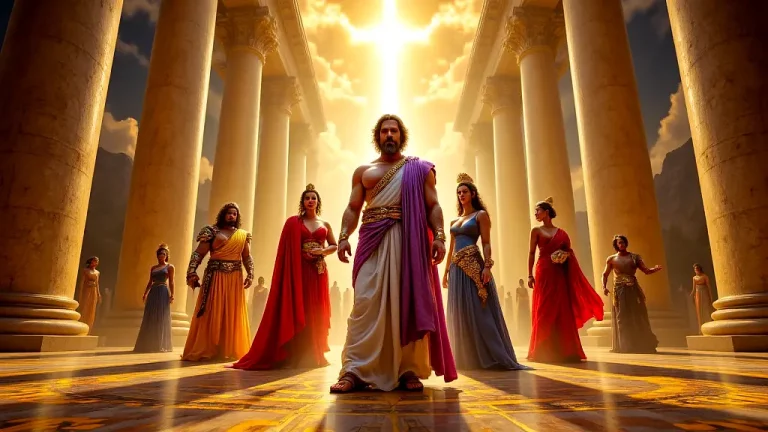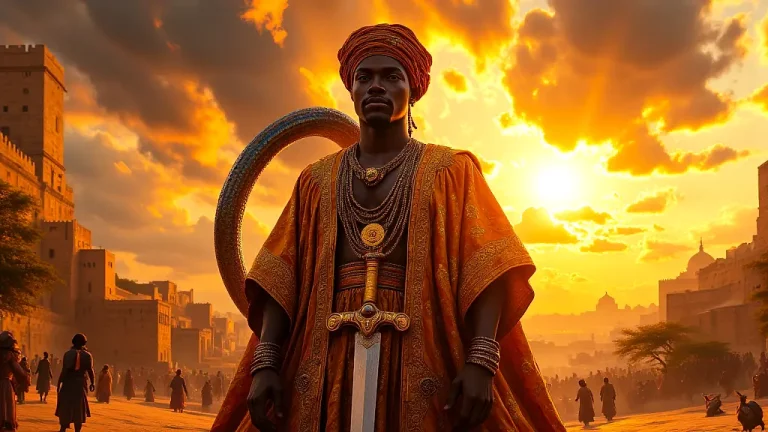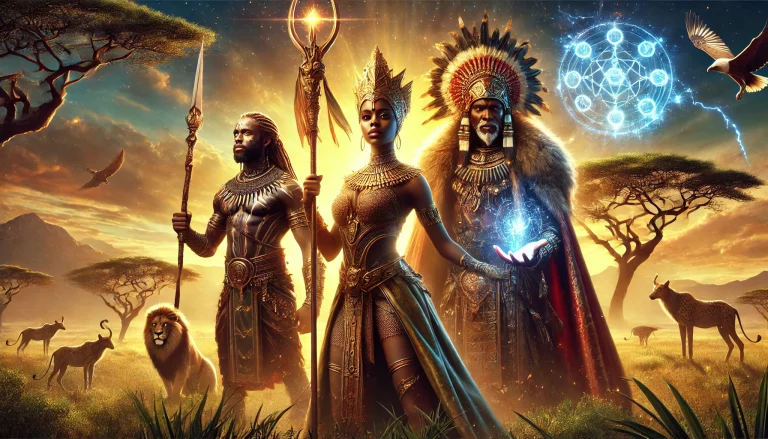Achelous: The Shape-Shifting River God Of Greek Mythology
In Greek myths, there is a mix of nature and gods. Rivers, mountains, and forests were sometimes gods with their own powers and separate personalities. Achelous is one of these gods. He is not mentioned as often as others, but he clearly stands for the connection between water and life. He does not only mean one specific river but instead means all freshwater sources together.
Key Points:
- Achelous is the Greek god of rivers and freshwater, representing fertility, growth, and all rivers combined.
- He could shape-shift into forms like a bull, a serpent, or a man, symbolizing the strength, movement, and connection of rivers in nature.
- Achelous’ duel with Heracles for Deianera led to the creation of the Cornucopia, a lasting symbol of abundance and prosperity.
- The Sirens, linked to Achelous in myths, reflect rivers’ beauty and danger, connecting his spirit to temptation and risks.
- The god Achelous is tied to the real River Achelous, Greece’s longest river, important for farming, borders, and ancient rituals.
- Rituals near rivers honored Achelous, with offerings to thank him for protection, farming success, and balanced natural forces.
- Rivers, like Achelous, were seen as bridges connecting the human world with the divine, symbolizing life’s unpredictability and renewal.
Achelous was honored because he brought fertility to the land, food for people, and success to farms in ancient Greece. This brings up how closely water and life were seen as the same thing. It’s no surprise that many saw rivers as both natural and spiritual. The ways stories describe Achelous are as fluid as the fresh water connected to him.
He could appear as a large bull, or a snake-like dragon, or even a man with horns. This shift in form matched the nature of water. It is a resource all life depends on, but it could also cause harm when it flooded or overflowed unpredictably. Different writers from the past had different ideas about him.
For example, Ovid talked about his battles, but Hesiod mentioned his birth from Oceanus and Tethys. The two sides to Achelous – being an actual river but also a major god – make people still think about what he meant to the Greek people, who saw nature as holy.
Achelous: Overview and Key Facts
| Aspect | Details |
|---|---|
| Name and Etymology | Achelous (Ἀχελώϊος in Greek). People believe the name comes from old Greek words. It is thought to mean “water source” or “one who washes away sorrow.” |
| Domain | God of rivers and fresh water. He is also connected to fertility and is thought of as the spirit of all fresh water in Greek myths. |
| Parents | The son of Oceanus (a Titan of the ocean) and Tethys (a Titaness linked with fresh water). He belongs to an ancient family of water gods. |
| Cultural Significance | People saw him as the most important river god and the oldest one. He represented how water is both life-giving and able to bring big changes. He mattered for survival and for spiritual ideas in ancient Greece. |
| Shape-Shifting Powers | He was known to change shape. He appeared as a bull, a snake, and a man, which stood for the way rivers can change how they look and behave. |
| Major Mythological Role | He is part of well-known Greek myths. One of his stories was his fight with Heracles for Deianera. He also is said to have created the Cornucopia – a horn that became a symbol of abundance. |
| Physical Representation | In artwork, he is often shown as a horned man, a bull, or a mix of both. This connects to the idea that he was both a natural force and a god. |
| Connection to Geography | His name is linked to the real River Achelous, which is the longest river in Greece. People in ancient Greece tied this to his role as a god and gave him great importance. |
| Symbolism | Things like fertility, renewal, and adaptability were linked to him. Water symbolized both life and danger. |
| Worship and Rituals | People showed respect by making offerings near rivers or calling on him during farming. They thought of him as special and included him in festivals. |
Getting to Know Achelous: The Greek God of Rivers
If we want to understand Achelous better, there’s a lot we need to look at. This includes his stories, what he stood for, and how important he was to people in ancient Greece. In these myths, symbols, and cultural ideas, he came across as someone with a big role connected to rivers. He stood for change and the ability rivers have to support life.
It makes sense to look at how Achelous was linked to these ideas about rivers being unpredictable but also essential for survival. These ideas show why he was important to Greek mythology. Rivers provided life. But they could also remind people of their power to shift and disrupt lives.
Achelous in Greek Mythology: A Symbol of Change and Life
Achelous had an important place in Greek mythology as the oldest and most well-known river god among the Potamioi. These are the spirits of rivers that were said to come from the Titans named Oceanus and Tethys. He wasn’t seen as just one river.
Instead, he stood for all rivers and all freshwater, which were needed for life and farming in Greece. People saw Achelous as having many sides, and his role was important because freshwater was necessary for ancient life. Freshwater streams helped water crops, fed people, and supported fields where food could grow.
However, he was also strongly linked with the idea of change. This connection came both from how he could physically shift forms and from how rivers can move, cut into land, and make new paths. The changing nature of Achelous gave Greeks something to think about. They saw a connection between rivers and life itself. Just as rivers could give life, they could also destroy.
People believed Achelous acted as both a protector and a sign of instability. He symbolized several things:
- Representation of Freshwater: He stood for the need for rivers and streams in supporting survival and farming in Greek society.
- Shape-shifter: Achelous could take on different forms, like a bull, serpent, or man, which explained the many ways rivers might change over time.
- Water and Growth: Achelous was connected to farming and areas that were fertile because of water, standing for how water brought growth and success.
With these roles, Achelous made people think about how water was both necessary and spiritual. People respected him as a natural power and also something holy that connected their lives to nature.
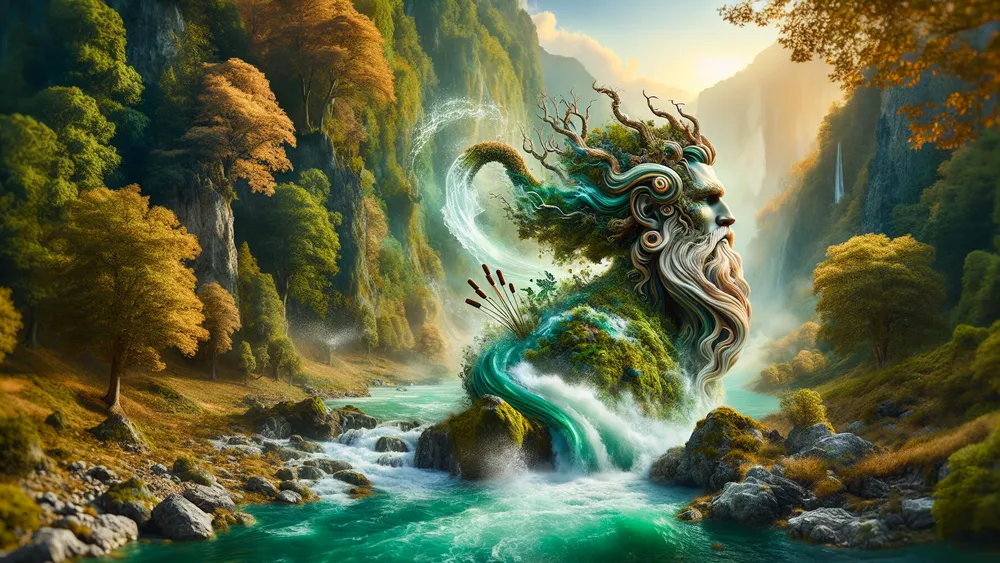
Achelous, the Greek river god, symbolized the essential role of freshwater in life, agriculture, and change, while also being linked to both growth and unpredictability.
Why Rivers Were So Important in Ancient Greece
Rivers like Achelous were a key part of life for the Greeks. They were important both for practical uses and spiritual meaning. On a basic level, they mattered for farming. Rivers gave the freshwater that was needed to water crops, especially because much of the farmland was not fertile or easy to work with. As well, rivers also marked borders. They divided land naturally and helped city-states stay politically and economically stable.
But rivers were not just practical. For the Greeks, rivers were something holy. They represented something more. They had two sides – one where they could give life by watering the earth and helping cities grow, but another where they could be dangerous. Floods could ruin fields or homes. Achelous, as the god who stood for rivers, brought together both of these sides.
He was thought of as a giving and helpful god who supported crops and abundance. At the same time, he was also tied to change. People said he could change his form into a bull or snake, just like rivers can cut through land and move in different directions. This ability to change made him a protector, but also someone to respect or fear.
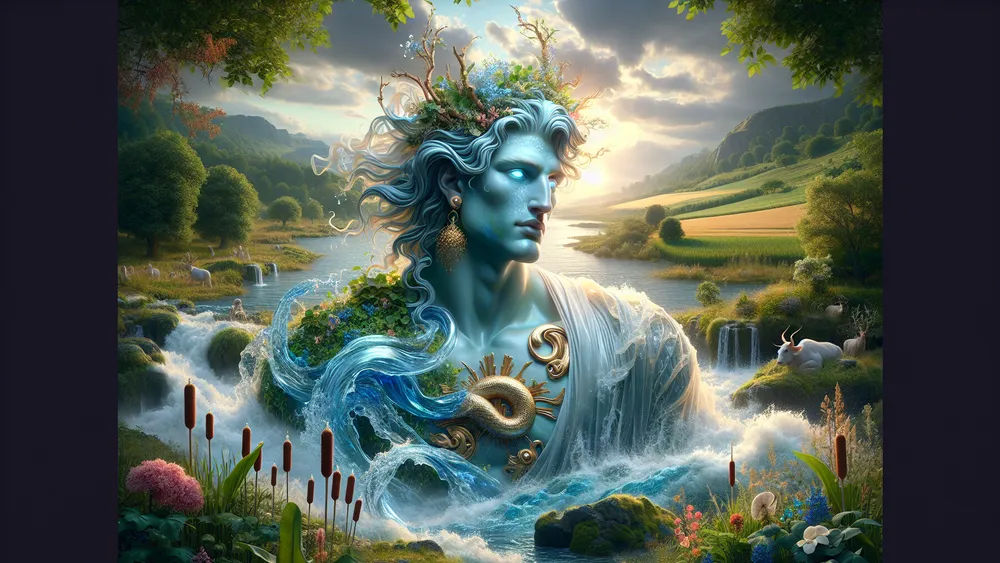
In this way, Achelous helped people understand water’s importance. Rivers gave life. But they could also remind people how unpredictable nature can be.
Achelous’ Shape-Shifting Powers: What They Represent
In Greek myths, Achelous was known for being able to take on different forms. This ability helped explain how rivers, too, could change and adapt. He changed into forms like a bull, a serpent, or a man, and each of these forms meant something different about him as a god of rivers. His power wasn’t just about showing control over nature. It stood for real things about rivers.
Rivers could be strong and bring life. But at the same time, they could also be unpredictable or even dangerous. Sometimes, rivers fed cities and farmland, giving people what they needed to survive. Other times, they moved and created new paths through the land, like how a serpent twists its body.
Then, there were times when rivers helped connect towns and civilizations, like how a person can link groups of people together. Achelous’ ability to change forms stood for these ideas about rivers.
Here are three forms of Achelous and what they meant:
- Bull: This form meant strength, fertility, and the power to grow crops. It also reminded people of how rivers could overflow, breaking fields and ruining land.
- Serpent: This meant how rivers bend and twist, often changing their course. It also stood for the mystery and hidden depths of water that weren’t easy to understand.
- Man: In human form, Achelous represented how rivers connected people. Freshwater gave cities life and allowed groups to grow near rivers.
When Achelous changed into these forms, he stood for how rivers mattered in Greek life. They were needed to survive, but they could also cause problems or be hard to control. In both their calm and wild moments, rivers shaped Greek cities and their way of living.
Myths and Stories About Achelous
Through the many stories told in Greek mythology, the importance of Achelous can be seen. These tales explain what he could do, the connections he had with others, and the ways his role continued to matter in culture over time. Some of the stories are about his abilities, some about his relationships, and others about how people thought of him long after his time.
The Famous Heracles and Achelous Duel: A Story of Losing and Gaining
One of the well-known stories about Achelous focuses on his fight with Heracles over Deianera, a mortal woman who was famous for being beautiful. Both Achelous and Heracles wanted to marry her. Achelous thought that, as a river god, he was better than the mortal hero. But Deianera could not decide, so the two men had to fight to figure it out.
During the battle, Achelous used his power to take on different forms. First, he turned into a serpent, which meant the changing and unpredictable way rivers move. Then, he became a bull, which stood for strength and the ability to bring life to the land.
But Heracles, who was known for his great power and clever thinking, defeated Achelous in his bull form and broke off one of his horns. This moment meant Heracles had won and was stronger than Achelous, showing that wild, natural forces like rivers could be controlled. The broken horn wasn’t thrown away.
In some versions of the story, Achelous gave the horn to the Naiads, who turned it into the Cornucopia, or the Horn of Plenty. The Cornucopia became a well-known symbol of wealth and agriculture. People pictured it full of fruit, flowers, and other gifts from the earth. So, even though Achelous lost, this loss created something important.
Giving up the horn meant creating a sign of new life and growth. This connected Achelous even more strongly to rivers, which could destroy things but also brought life and change.
The story about Heracles and Achelous teaches important ideas about humans and nature:
- Conflict Between Nature and Civilization: Achelous stood for the wild strength of nature, and Heracles stood for people trying to control it.
- Loss Leading to Growth: Even though Achelous lost, this led to the Cornucopia, which became a sign of abundance.
- Symbol of Fertility: By giving up the horn, Achelous became connected to ideas about growth, agriculture, and renewal.
This story shows how people have always thought about the struggles between nature and human control, as well as how those struggles could lead to balance and new things.
Achelous and the Sirens: The Dangerous Allure of River Legends
Some Greek myths say that Achelous was the father of the Sirens, creatures that were part bird and part woman. They became known for their beautiful songs, which pulled sailors toward them but led to disaster. Their mother is not always the same in different stories. Some say their mother was one of the Muses, like Terpsichore, who was linked to dance and singing.
Others said their mother was an Oceanid, a water spirit. Even though there are questions about their mother, the Sirens were always linked to beauty and danger. Just like Achelous stood for rivers that could help people but also cause harm, the Sirens were both something irresistible and something deadly.
Sailors who got close to them because of their music often wrecked their ships on rocks near the shore. This story reminds us that rivers, like the Sirens, were useful but also held dangers that people had to understand and respect. The connection between Achelous and the Sirens compares rivers to temptations. Rivers might look smooth or safe, but they often hide strong currents or the risk of flooding.
For the Greeks, Achelous reminded them of how rivers could attract people while still being risky. His link to the Sirens helps explain the idea that rivers were both important for life and something that could go wrong if people were not careful. Sailors needed to respect the Sirens, and at the same time, people who lived near rivers had to respect the power of water.
Here are some ways Achelous and the Sirens explain the meaning of rivers in Greek myths:
- Beauty and Danger Combined: The Sirens looked and sounded beautiful, but they were dangerous, just as rivers could help but also harm.
- Unpredictable Risks: Rivers seemed calm and peaceful but often carried hidden risks, like floods or strong currents.
- Respect for Nature: Both the Sirens and Achelous reminded people that nature needed to be respected because of how powerful it was.
The Greek myth of Achelous and the Sirens compares rivers to nature’s mix of beauty and danger, where something that seems safe or helpful can also bring great risk if not respected.
Achelous and His Fellow Gods: Friends or Rivals?
The way Achelous connected with other important gods like Poseidon, Zeus, and Demeter helps explain his special place in Greek mythology. Achelous was known as a river god, tied mainly to freshwater, unlike Poseidon, who ruled over the sea. Achelous and Poseidon represented different kinds of water: one coming from rivers that people needed for life, the other from the salty ocean.
While the myths never describe clear arguments or fights between them, their responsibilities were separate but still connected. For the Greeks, rivers flowed into the sea, which meant Achelous and Poseidon had a natural balance. Today, this idea could make people think about how freshwater and saltwater work together as parts of the water cycle.
Both gods showed that water could be something people depended on, but it could also bring destruction if it wasn’t controlled. Achelous’ connection to Zeus, who ruled over all gods, helps us see where Achelous belonged in the group of gods. Zeus, being the most powerful, had authority over all forces of nature, including rivers.
But while Zeus ruled the sky and used lightning, Achelous focused mostly on rivers and the water that humans and farms needed to survive. With Demeter, the goddess of farming, Achelous shared more in common. Both were linked to ideas like fertility and growth, things that helped keep the cycle of life going.
This overlap can also be seen in myths about the Cornucopia, a horn tied to Achelous and to Demeter’s connection with crops and abundance. Through these relationships, it becomes clear how Achelous related to the gods and what he represented in Greek culture: the life that freshwater brought, its dangers, and its role in sustaining people.
Here is a short version of Achelous’ relationships with these gods:
- Poseidon: The balance of freshwater and saltwater, with rivers connecting to the sea.
- Zeus: Achelous was under Zeus’ control, but his role was important for life and farming.
- Demeter: Both worked together, as they shared symbols like the Cornucopia to represent fertility and harvests.
Achelous’ Role in Greek Geography and Religion
Outside of myths, Achelous could also be found in the real world. The way ancient Greeks thought about their rivers and the link between nature and gods was influenced by what he meant. His role wasn’t only about stories. It also connected deeply to geography and how people practiced their religion.
The Real River Achelous: Where Myth and Land Meet
The River Achelous, the longest river in Greece, connects real places and the ancient stories told in myths. This river is over 220 kilometers long. It starts in the Pindus Mountains and ends in the Ionian Sea, and it has been very important to the people living near it.
It brought water to farmlands so crops could grow, while also separating the regions of Acarnania and Aetolia like a border. For the ancient Greeks, the river itself seemed similar to its name in myths – Achelous, the god of rivers. Much like the god was linked to fertility and growth, the real river was valuable to farming.
People also saw it as special to the gods, and many performed rituals and gave offerings to honor the spirit they believed lived in its waters. Over the years, the meaning of the River Achelous has changed, but it still matters. In earlier times, it mattered because it fed farms and divided political areas; people also saw it as having power from the gods.
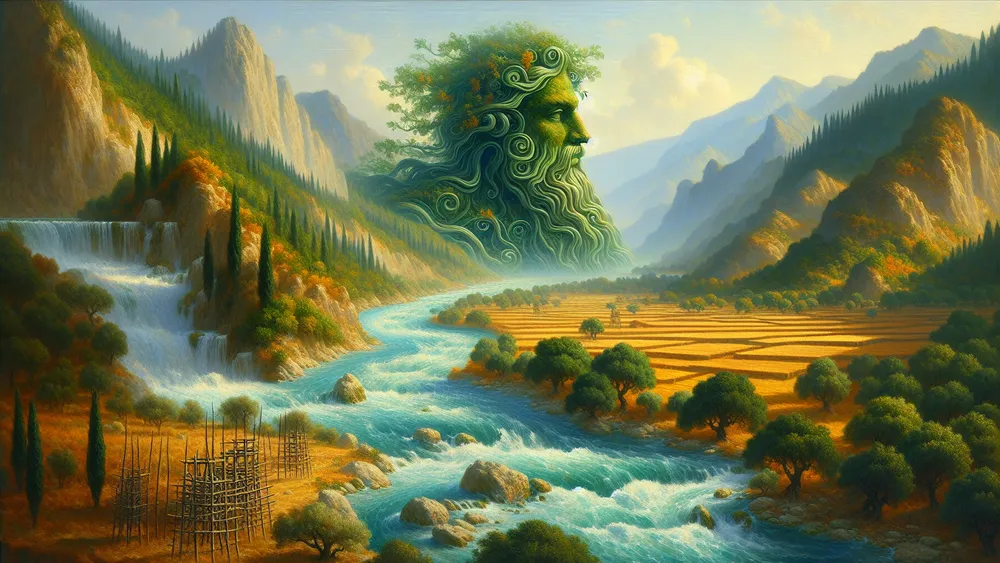
Today, it is still a water source for farming, and it helps define regional borders. The way its role has shifted shows how myths and real places were connected in the past and are still connected in some ways today.
Here is a table summarizing the roles of the River Achelous, both then and now:
| Role | Ancient Times | Modern Times |
|---|---|---|
| Religious Importance | Ceremonies held to honor the god of rivers | A site for cultural or historical tourism |
| Farming and Growth | Helped crops grow with irrigation water | Still used for farming and studied ecologically |
| Borders Between Areas | Marked territories like Acarnania and Aetolia | Still works as a regional dividing line |
Honoring Achelous: Rituals for Prosperity and Protection
In ancient Greece, people respected Achelous as a god who helped life grow and protected rivers. They held ceremonies by riverbanks, where they poured wine, milk, or honey into the water, believing these offerings would honor him. They also gave grain and fruits as gifts. These actions were a way to recognize his role in helping crops and ensuring there was enough food to live on.
At specific times, like during farming festivals, larger ceremonies were organized. During these events, they asked him to make the land fertile and to give them plenty of crops to harvest. Because they thought that the god in the river could bring balance between people and nature, these ceremonies became very common.
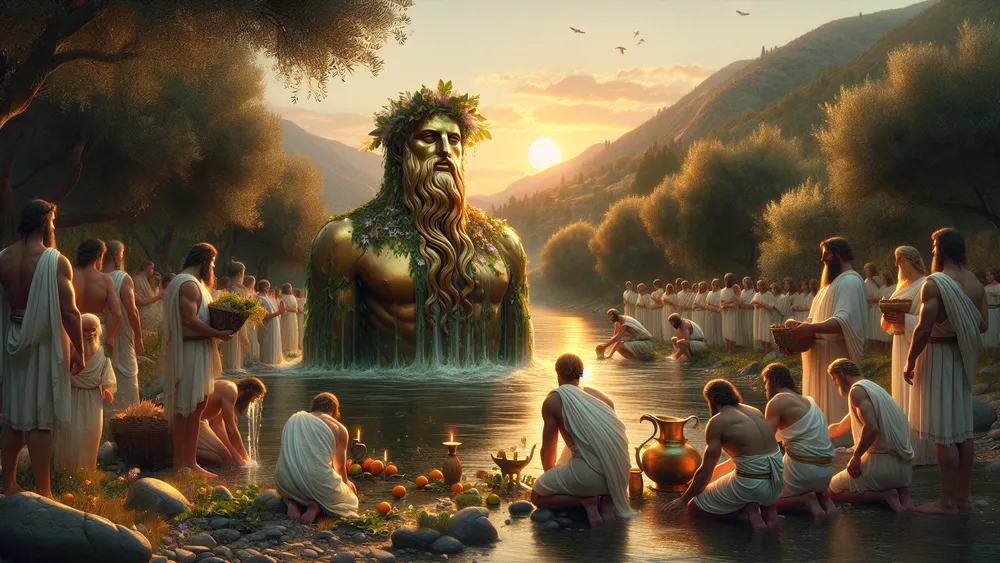
Unlike today, when people might take steps to conserve water or protect the environment, the ancient Greeks saw rituals as a way to keep the relationship with nature working well. These offerings mattered because they believed the rivers – and the god connected to them – controlled things they could not.
Why Rivers Were Seen as Bridges to the Divine
In Greek myths, rivers like Achelous were special because they connected the world of people and the world of gods. They were seen as something in between – not fully part of the earth, but not completely apart from it either. This idea came from how rivers could flow, always changing and moving the land around them.
The Greeks thought this constant movement meant rivers acted as a way to cross over from the physical world into the spiritual one. For the people of Greece, this belief was important. They thought rivers could wash away unclean things and help people connect with gods.
They also believed rivers were paths that souls of the dead could use to move closer to the divine. The god Achelous, who they saw as the spirit of all rivers, seemed to represent these ideas. In different myths, Achelous would change his shape and take on different forms, much like rivers themselves that were always moving and different.
Because rivers had this special meaning, they became a big part of rituals and stories. People felt they needed rivers to understand how the world of gods and the world of humans were tied together. A river was a way to connect two things but was also its own space where something in between could exist. This belief strengthened how important rivers were in both life and religion.
Rivers in Greek myths were seen as a link between humans and gods, symbolizing constant change, cleansing, and a bridge for souls, while also having their own unique place.
Pantheon of Greek Mythology Geography Ideas
In Greek mythology, places like rivers, mountains, and seas were very important. These places were not just part of the land but were connected to the stories and beliefs about gods and other spiritual forces. For example, Mount Olympus, the River Styx, and the Aegean Sea were special locations.
They weren’t just where stories happened – they were seen as spots where the physical world and the world of the gods could come together, which made them holy to the Greeks. To the people of ancient Greece, geography and their stories about gods were tied together. This connection mattered for how they told their myths or carried out traditions in rituals and ceremonies.
If this connection interests you, there’s a list about Greek Geographical Concepts that explains these ideas more fully. Some of these ideas include how natural landmarks, like rivers and mountains, meant both physical spaces and spiritual pathways.
FAQs
1. Who were the parents of Achelous, and what is his origin?
The parents of Achelous were the Titans Oceanus and Tethys, making him one of the eldest river gods in Greek mythology.
2. What symbolism is associated with Achelous’ shape-shifting abilities?
The symbolism associated with Achelous’ shape-shifting abilities reflects the fluidity, unpredictability, and life-giving nature of rivers.
3. How is the Cornucopia tied to Achelous’ mythology?
The Cornucopia is tied to Achelous’ mythology through the story of Heracles breaking Achelous’ horn during their duel, which transformed into a symbol of abundance and prosperity.
4. What is the connection between the River Achelous and the god?
The connection between the River Achelous and the god lies in the river’s physical prominence in Greece, reflecting the deity’s status as the primordial personification of all freshwater.

